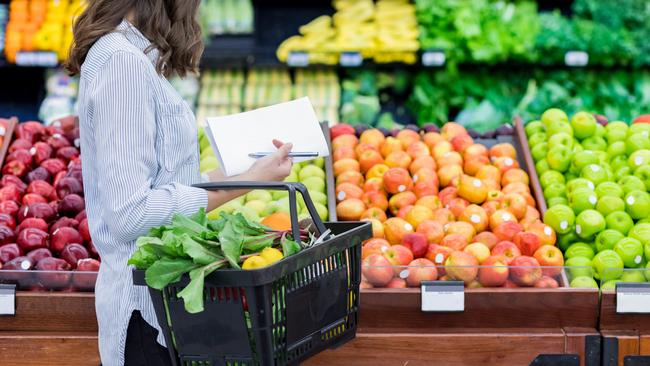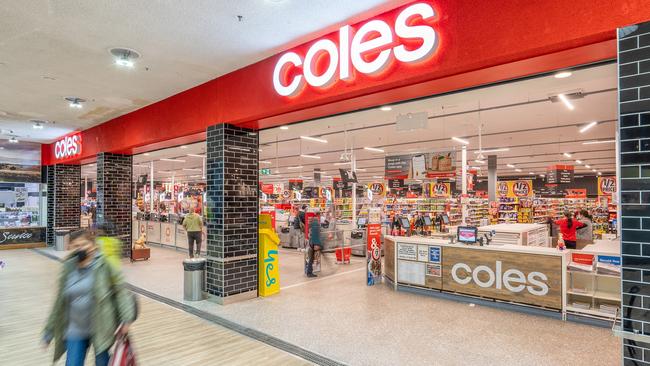Food inflation up more than 8 per cent in the first quarter, UBS says
The cost of food prices at the supermarket is the highest in decades and there’s no relief in sight, new data shows.
The rapid increase in food prices at the supermarket has accelerated to more than 8 per cent, reflecting decades-high inflation rates for both fresh and packaged foods.
The spike is adding extra pressure on household budgets already buckling under rising interest rates and cost of living pressures.
The cost of basic foods would have been much higher if it wasn’t for Woolworths and Coles offering discounts and promotions at their stores and there’s no relief in sight with grocery prices expected to remain elevated well into 2023.
A new report on the supermarket industry and food prices from investment bank UBS has revealed that food inflation for the first quarter of fiscal 2023 accelerated to 8.3 per cent at Woolworths and 8 per cent at Coles.
That was up sharply from food inflation of 5.6 per cent in the final quarter of 2022 for Woolworths and 5.5 per cent for Coles.
“Food inflation is expected to reach 8.7 per cent over the next 12 months,” warned UBS analyst Shaun Cousins.
“Generally this is as high as I have seen certainly in the last decade, this is the highest rate of inflation that Australian consumers would have seen for many years.”

While spending remains resilient for now among consumers and there is some optimism around Christmas, spending at supermarkets is expected to see a strong push into cheaper home brand groceries.
It comes as the leading supermarket chains Woolworths and Coles unveil over the next few weeks their first quarter trading which is expected to shed more light on the impact of food inflation, the lead up to Christmas and pressures on household budgets.
The dire findings by UBS were drawn from around 60,000 weekly prices across Woolworths and Coles and promotional activity at the two supermarket leaders that together account for the majority of groceries bought in Australia.
The UBS survey found that on average across both supermarket chains food prices spiked 8.2 per cent with the cost of fresh food leaping ahead by 9 per cent in the first quarter against 5.7 per cent in the fourth quarter of 2022.

The cost of packaged or dry groceries rose 7.7 per cent for the first quarter, up from 5.5 per cent in the fourth quarter.
Mr Cousins said the pace of food inflation at Woolworths and Coles would have been much faster if the supermarkets weren’t offering discounts and promotions, but the sheer size and breadth of higher costs coming through the economy made it almost impossible not to pass prices on to shoppers.
“Promotions are still occurring, but the quantum of inflation coming through the system is such that you cannot not pass it on, you can’t hold it back,” he said.
“Promotions will continue and remain important, also locking down prices and price freezes for a number of time will be important for that cohort of customers that are under greater pressure and food inflation would have been higher if not for promotions.”
To cushion that blow shoppers are turning to cheaper, more affordable foods.
Goldman Sachs analyst Lisa Deng said recent conversations with leading consumer packaged good and homewares suppliers, revealed evidence of a consumer shift to value though volumes.
“There are increasing signs in value shift - as an example canned foods are having a strong growth year on year - and it is expected that it will become increasingly obvious in the second half of fiscal 2023 as consumers feel the increasing pinch of higher cost of living,” Ms Deng said.
This pricing pressure will continue as suppliers seek further price rises from retailers to cover increasing input costs in their own businesses.
“Most consumer packaged goods companies have put up 2-3 rounds of price increases by now and there is likely more to come in fiscal 2023. We understand that most of these have been passed through to consumers though there has been more collaboration with retailers to drive innovation, positive mix, targeted offers to insulate volume impact.”
“The retailers are calling this out and are starting to see this shift (to lower priced groceries) occur,” said UBS analyst Mr Cousins.
“The consumer base is very broad and are continue to do very well, some are having a hard time, so how consumers react is a function of that as well. Some are trading down.
“Food inflation and for some consumers cost of living pressures are expected to weigh on mix, to either lower ticket or entry-level private label,” Mr Cousins said.






To join the conversation, please log in. Don't have an account? Register
Join the conversation, you are commenting as Logout